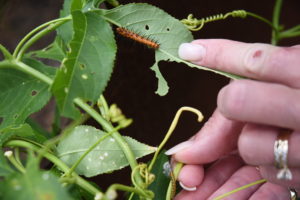Junior Master Gardeners “bug out” in the backyard
Virtual bug camp for kids at The Gardens reaches young gardeners across U.S.
The Junior Master Gardeners, JMG, and the Gardens at Texas A&M University are keeping things lively with the Growing Good Kids virtual course “Bugging Out in the Backyard,” held recently for camp participants around the nation. This year, due to COVID-19, the camp was held virtually.
This two-week camp shipped supplies needed to keep the participants engaged and learning about bugs found right in their own backyard. The course included six fun-filled interactive sessions to investigate bugs complete with a bug kit for each day. Students who completed the course earned their JMG Golden Ray Series certification for “Insects in the Garden.”
Each of the six sessions was streamed live and included an interactive 20-30 minutes in the Leach Teaching Gardens with Junior Master Gardener camp counselor Randy Seagraves, JMG curriculum coordinator and Texas A&M AgriLife Extension Service program specialist for horticulture, College Station. Broadcast via Facebook Live, participants were able to re-watch the sessions at any time.
Registration for the Backyard Bugging “camp-in-a-box” format included the needed activity supplies for all six of the live sessions. They were packaged by session camp day, and the box was mailed directly to campers to have ahead of the first session. Session kits included everything from a handbook to follow along all the way to pipe cleaners and google eyes for some crafting and an insect predictions chart sheet.
“It’s great for them to have all the materials – just like if they were at a face-to-face camp,” Seagraves said. “At the beginning of each camp session and after the camp song, we all got to open and discover the session packages together.”
“For our audience of elementary-aged campers, we’re kept our live, virtual sessions to 20ish minutes in length,” Seagraves said. “Our priority is to make these distanced sessions as interactive as possible. All sessions include a ‘do it with us’ component so kids can see how to do something new and experience it alongside us.”
Daily Sessions
Session one discussed what makes up an insect, including a song describing the parts of an insect led by Lisa Whittlesey, national JMG program coordinator and AgriLife Extension specialist for horticulture, College Station. The camp song followed the tune of “Head, Shoulders, Knees and Toes,” and was sung at the beginning of every virtual session.
Session two included learning about the transformation, or metamorphosis, that insects go through throughout their lifecycle. Participants then built a necklace representing the different life cycle stages that also served as their name tag for the remainder of the camp.

“Even with the increasing heat, there are a lot of pollinators in the garden,” Seagraves said “Butterflies are probably most popular, especially right now, because we can find them in different stages of their life cycle. Kids love discovery and the virtual Backyard Bugging Camp encourages that curiosity and investigation. The hands-on sessions during camp helped them to understand events like metamorphosis that’s happening in the world around them.”
Session three was an insect collection day where campers went out in search of different insects and used their camp kits to build a bug sucker kit to better capture their insects for observation.
“We had several students find assassin bugs,” said Whittlesey. “Although the name sounds scary, they are beneficial and actually do a good job of eating some of our bad insects that feed on plants.”
Session four, called Chew on This, discussed the different ways that insects use mouthparts to access different foods.
Insects can have a variety of different types of mouthparts, she explained. “Our campers got to see examples of chewing mouthparts, piercing and sucking mouthparts, siphoning and sponging mouthparts. They used their camp supplies to pretend to be insects with these different mouthparts. Afterward, we showed close up pictures and actual specimens of insects for the children to observe.”
In session five, participants strolled throughout their garden areas investigating whether or not the insects found were friends or foes.
This session allowed participants to collect insects and put into practice the things they had learned about what makes an insect an insect. They observed and recorded information about the body regions, legs, antennae, mouthparts and wings of insects that they collected.
“They learned about some of the most common beneficial insects and how to identify them and also learned about some of the biggest insect pests that are problems in our gardens,” Whittlesey said.
The final day with session six included an interview with a scientist, Molly Keck, AgriLife Extension entomologist, San Antonio. Keck explained why everyone cares about insects, from nurses and doctors to farmers and ranchers and homeowners.
“While most people consider insects pests, for the most part, insects are actually good. They help us to have food on our tables,” Keck said.
As part of the course graduation, participants earned their “Insects in the Garden” certificate, a part of the Golden Ray Series of the Junior Master Gardener handbook. Campers also received a Gardens patch, a JMG tattoo, a Gardens hummingbird tattoo, a Gardens seed packet to attract pollinators and a Gardens connect card.
“This class was so fun for our Junior Master Gardener staff and the Texas A&M Leach Teaching Gardens to offer this summer,” said Whittlesey. “Be checking out the JMG website for more fun activities, classes and details about how to order curricula or start your own JMG group.”



